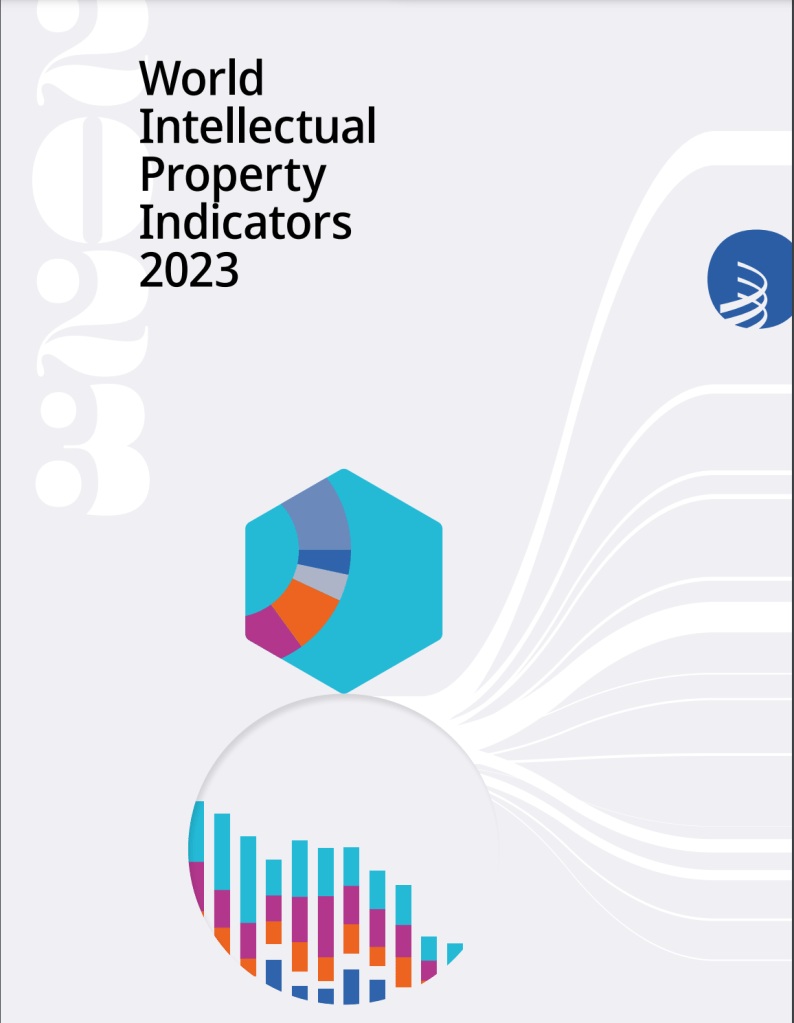
The World Intellectual Property Organization (WIPO) recently published its annual World IP Indicators for the year 2023, detailing the different trends in the filing of IP applications and the subsequent grants by IP offices across different jurisdictions. In this short post, I’ll take a look at the India-specific figures in terms of patent filings, grants, and procedural data about the Indian Patent Office.
Countries with Highest Applications and Grants
But before we get to India, let’s take a look at the countries with the most applications and grants. The Chinese Patent Office received the highest number of patent applications in 2022 (1.6 million) followed by the US (594,340) and Japan (289,530). The sequence remained the same for patent grants as well with China witnessing the highest numbers of patents granted (798,347), followed by the US (323,410) and Japan (201,420). With this, the countries with the highest number of patents in force are (you guessed it right) China (4.2 million), followed by the US (3.3 million) and Japan (2 million).
Trends from India
Witnessing a growth of 25.2%, a total of 77,068 patent applications were filed in India in 2022. Of this, 38,551 applications were filed by Indian residents and 38,517 were filed by non-residents. Thus, this time residents applications have marginally overtaken the applications filed by non-residents. Additionally, 55,718 patent applications were filed by applicants from India across different patent offices. Of the 38,517 non-resident applicants filed in India, applicants from the US filed the most patent applications (249,294), followed by applicants from Japan (4,583), China (3,914), the Republic of Korea (2,817), and Germany (2,600).
However, India witnessed a marginal dip (of 231) in the number of patents granted in 2022 in comparison to the patent granted in 2021. In 2022, 30,490 patents were granted by the Indian Patent Office, with 7,787 patents to Indian residents and 22,703 patents to non-Indian residents. With these grants, the number of patents in force in India is 128,663 with an average lifespan of 11.4 years, which is 1.6 years lower than what it was in 2017 (13 years).
Figures on the Functioning of the Indian Patent Office
A total of 51,025 applications were processed by the Indian Patent Office in 2022. Out of this, patents were granted in 30,490 and rejected in 5,198, while 15,337 applications were abandoned or withdrawn. In contrast to this, Türkiye and the US granted patents to less than half of the applications processed in 2022.
Of the selected 20 offices, India has the 6th highest number of examiners (597) with the US having the most examiners (8,234). The indicators also state that the average years of experience possessed by an Indian examiner is 5.9, which is quite low when compared to the experience of its Austrian counterpart (17.7 years).
In terms of pendency, India has the second highest average pendency time (51 months), after Mexico (56 months), for first office action and final decision. Whereas, the Russian Federation has the least pendency time of 4.2 months. Presently, 249,294 applications are pending in the Indian Patent Office.
Comments
The rise in the number of applications filed by Indian residents in comparison to non-resident applicants should definitely be applauded as after consistently lagging behind for years, Indian inventors are finally able to explore the patent system to a similar extent as non-residents. However, does this high number of patent filings and eventual grants indicate a growth in innovation? Swaraj writes in to suggest that there are at least 3 nuances to keep in mind before one jumps to this conclusion:
1) The quality of grants is a distinct question altogether, and one that often does not receive sufficient discussion. That is to say, granted patents do not necessarily equate to quality patents. It would be very useful to have metrics to measure this, but as far as I know, data is sparse in this regard.
2) Even ignoring the question of quality, there has been no evidence to support the often presupposed assumption that more patents = more innovation.Not only does innovation in different sectors require different types of incentives and policies, but some sectors actively do better with development friendly’ IP rather than standard maximalist IP.
3) And finally – even if we assume high quality, and well thought out policy – the patents do need to be worked and not simply hoarded and sat upon! And on that at least, the data so far suggests that (certain large) companies are not only reluctant to show that they’re working their patents, but also lobby to change the law requiring them to show it!
It does appear that many changes are happening in the Patent Office, and it would be wonderful to see these nuances taken seriously and discussed further, to help India utilise its IP systems to maximise the talent and innovative capacity it has!
- SEO Powered Content & PR Distribution. Get Amplified Today.
- PlatoData.Network Vertical Generative Ai. Empower Yourself. Access Here.
- PlatoAiStream. Web3 Intelligence. Knowledge Amplified. Access Here.
- PlatoESG. Carbon, CleanTech, Energy, Environment, Solar, Waste Management. Access Here.
- PlatoHealth. Biotech and Clinical Trials Intelligence. Access Here.
- Source: https://spicyip.com/2023/11/wipo-ip-indicators-2023-india-accelerates-in-the-race-towards-the-pot-of-gold-but-is-there-one.html
- :has
- :is
- :not
- 1
- 11
- 13
- 15%
- 17
- 2%
- 20
- 2017
- 2021
- 2022
- 2023
- 22
- 234
- 25
- 27
- 30
- 420
- 51
- 6th
- 7
- 77
- 8
- 9
- a
- Able
- About
- accelerates
- across
- Action
- actively
- Additionally
- After
- also
- altogether
- an
- and
- appear
- applicants
- applications
- ARE
- AS
- assume
- assumption
- At
- austrian
- average
- BE
- been
- before
- behind
- Better
- but
- by
- Capacity
- certain
- change
- Changes
- China
- chinese
- Companies
- compared
- comparison
- conclusion
- consistently
- contrast
- Counterpart
- countries
- data
- decision
- definitely
- Detailing
- Development
- different
- Dip
- discussed
- discussion
- distinct
- do
- does
- end
- Even
- eventual
- evidence
- examiner
- experience
- explore
- extent
- far
- Federation
- Figures
- filed
- Filing
- filings
- final
- Finally
- First
- followed
- For
- Force
- from
- functioning
- further
- Germany
- get
- Gold
- granted
- grants
- Growth
- guessed
- Half
- Happening
- Have
- having
- help
- High
- highest
- However
- HTTPS
- i
- I’LL
- if
- image
- in
- Incentives
- india
- Indian
- indicate
- Indicators
- Innovation
- innovative
- intellectual
- intellectual property
- Inventors
- IP
- IT
- ITS
- Japan
- jumps
- jurisdictions
- Keep
- Know
- korea
- lagging
- large
- Law
- least
- less
- lifespan
- Lobby
- Look
- Low
- lower
- many
- max-width
- maximalist
- measure
- Metrics
- Mexico
- million
- mind
- months
- more
- most
- necessarily
- Need
- no
- nuances
- number
- numbers
- of
- Office
- offices
- often
- on
- ONE
- only
- or
- organization
- out
- page
- patent
- Patents
- pending
- plato
- Plato Data Intelligence
- PlatoData
- policies
- policy
- Post
- pot
- presently
- procedural
- processed
- property
- published
- quality
- question
- quite
- Race
- rather
- receive
- received
- recently
- regard
- Rejected..
- remained
- Republic
- require
- residents
- right
- Rise
- russian
- russian federation
- same
- say
- Second
- Sectors
- see
- selected
- Sequence
- seriously
- Short
- should
- show
- similar
- simply
- So
- so Far
- some
- standard
- State
- subsequent
- sufficient
- suggest
- Suggests
- support
- system
- Systems
- Take
- taken
- Talent
- terms
- than
- that
- The
- the Law
- their
- Them
- There.
- These
- this
- thought
- Thus
- time
- to
- Total
- Trends
- Türkiye
- types
- us
- useful
- very
- was
- we
- WELL
- were
- What
- when
- whereas
- which
- while
- with
- withdrawn
- witnessed
- witnessing
- wonderful
- worked
- working
- world
- world intellectual property organization
- World Intellectual Property Organization (WIPO)
- would
- year
- years
- you
- zephyrnet












